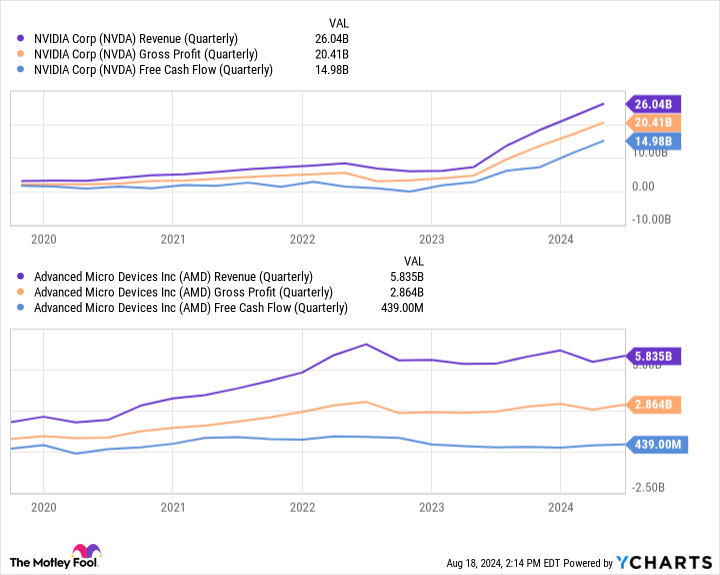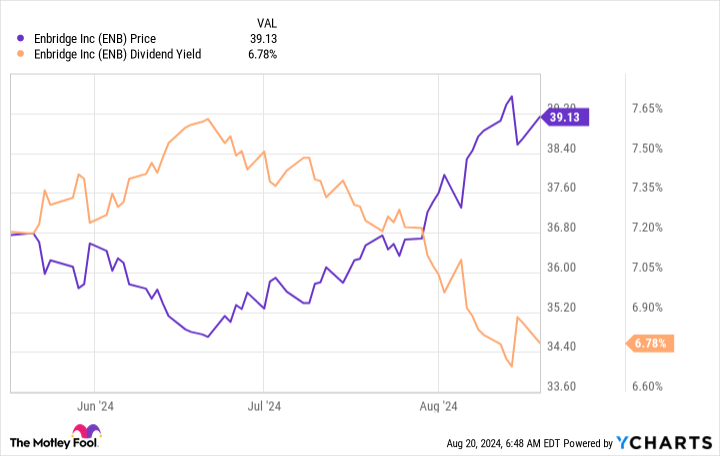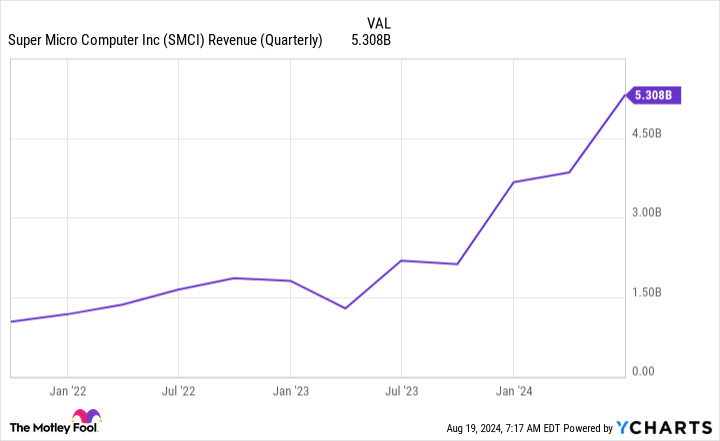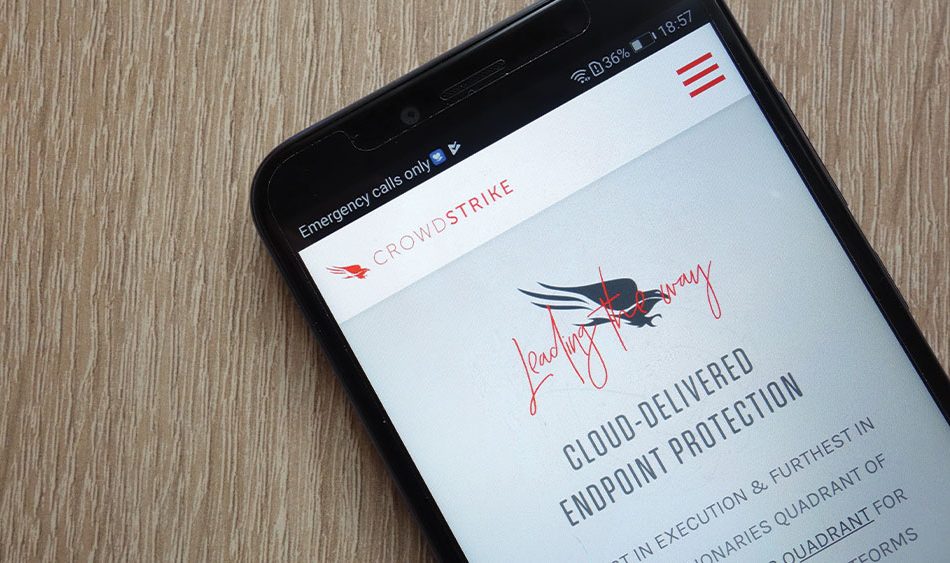asdasdadasd
asdasdasdasdasd
Berkshire Hathaway Now Owns 27 Million Shares of This Stock. Should You Follow Warren Buffett's Lead?
Berkshire Hathaway (NYSE: BRK.A)(NYSE: BRK.B) sold off several stock positions during the second quarter, but Chubb (NYSE: CB) was one of the few stocks that Warren Buffett and his team kept accumulating, adding another 1.1 million shares in the second quarter.
This marks the fourth consecutive quarter that Berkshire added shares of the global insurer to its portfolio. The conglomerate now owns 27 million shares, or $7.4 billion in Chubb stock. Here’s why it could be wise for investors to follow Buffett’s lead today.
Why Buffett loves investing in insurance businesses
The insurance business has many attributes that appeal to long-term investors like Warren Buffett. For one, these companies enjoy consistent demand for their products. Chubb, for example, is one of the world’s largest property and casualty insurers, covering risk categories that include personal automotive, homeowners, accident and health, agriculture, and reinsurance.
Another appealing aspect of the business is the cash flow it can generate. Insurers operate differently from traditional businesses by collecting their revenue (premiums) up front and paying out claims costs later. Because it doesn’t pay until a customer files a claim, insurers sit on a pile of money they can hold and invest but don’t own, called “float.”
For Buffett, insurance companies and the cash flow they generate are a considerable portion of Berkshire’s value, partly because, as he said in Berkshire Hathaway’s 2021 letter to shareholders, insurance products “will never be obsolete, and sales volume will generally increase along with both economic growth and inflation.”
Berkshire Hathaway owns several insurance companies under its umbrella, including GEICO, General Re, Berkshire Hathaway Reinsurance, and Alleghany, which it acquired two years ago for $11.6 billion.
Chubb has provided excellent returns for investors
Chubb’s business has several advantages. It is one of the world’s largest property and casualty insurers covering various risks. It has displayed excellent underwriting discipline in the highly competitive insurance industry and consistently beats its peers when it comes to writing profitable policies.
Thanks to its strong underwriting and steady demand, Chubb has steadily grown its top and bottom lines. Over the past decade, Chubb’s revenue and net income have increased by about 11% compounded annually. In the last year, the insurer has delivered a record $15.2 billion in free cash flow, representing capital it can reinvest in the business, pay out in dividends, or use to buy back shares of its stock.
With its disciplined underwriting and steady demand, it’s no surprise that Chubb has delivered excellent returns for long-term investors. The company has steadily raised its dividend over the past 31 years. Over that same period, Chubb’s total compound annual return (including reinvested dividends) of 12.9% has outpaced the S&P 500‘s 10.4% return.
Here’s why Chubb can continue to deliver
JPMorgan Chase CEO Jamie Dimon recently warned that “there are still multiple inflationary forces in front of us” due to fiscal deficits, rising interest rates, and stubbornly high inflation. If Dimon is correct, Chubb can continue to deliver for investors for several reasons.
For one, the company enjoys steady demand, and the industry’s backdrop favors insurers. Insurers have faced rising claims costs over the past several years due to weather-related events, economic and social inflation, and less availability of reinsurance coverage.
This is known as a “hard market” in insurance, and risks related to geopolitical conflict, cybersecurity, climate-related catastrophes, and unrest will likely stick around. As a result, insurers can raise premiums and be more selective about the policies they are willing to cover — which can help investors stay ahead of any inflationary pressures should they reemerge.
Not only that, but Chubb has a $113 billion investment portfolio mainly invested in fixed-income securities. Last year, the insurer earned $4.9 billion in investment income, up 32% year over year. Through the first six months of 2024, its net investment income has increased another 27% from last year.
Chubb has a proven track record of growth in an expanding economy. However, if inflationary pressures persist, it has the pricing power to adapt to rising costs and the investment portfolio to take advantage of higher interest rates — giving it excellent potential for the next decade and beyond.
Should you invest $1,000 in Chubb right now?
Before you buy stock in Chubb, consider this:
The Motley Fool Stock Advisor analyst team just identified what they believe are the 10 best stocks for investors to buy now… and Chubb wasn’t one of them. The 10 stocks that made the cut could produce monster returns in the coming years.
Consider when Nvidia made this list on April 15, 2005… if you invested $1,000 at the time of our recommendation, you’d have $792,725!*
Stock Advisor provides investors with an easy-to-follow blueprint for success, including guidance on building a portfolio, regular updates from analysts, and two new stock picks each month. The Stock Advisor service has more than quadrupled the return of S&P 500 since 2002*.
*Stock Advisor returns as of August 22, 2024
Courtney Carlsen has no position in any of the stocks mentioned. The Motley Fool has positions in and recommends Berkshire Hathaway. The Motley Fool has a disclosure policy.
Berkshire Hathaway Now Owns 27 Million Shares of This Stock. Should You Follow Warren Buffett’s Lead? was originally published by The Motley Fool
2 "Magnificent Seven" Stocks That Could Create Lasting Generational Wealth
Historically, the stock market has helped create huge amounts of generational wealth. However, all stock investments are not created equal.
Investors keen on building lasting generational wealth should opt for stocks of companies with strong fundamentals, robust financials, and sustainable growth strategies.
Apple, Amazon, Nvidia, Microsoft (NASDAQ: MSFT), Alphabet (NASDAQ: GOOG) (NASDAQ: GOOGL), Tesla, and Meta Platforms, collectively known as the “Magnificent Seven,” are the seven technology stocks that have demonstrated impressive performance in the past year. Of these, Microsoft and Alphabet are well positioned to continue generating robust returns even in the coming years — wealth that can be passed down through generations.
Here’s why.
Microsoft
Microsoft stock is nearly 10% below its 52-week high of $468.35 in early July 2024. The stock failed to take off after the fourth-quarter fiscal 2024 earnings results (ending June 30) despite surpassing revenue and earnings estimates. This was mainly due to slower-than-expected growth in its Azure cloud business.
Yet, the long-term growth story of this prominent player in the $5.06 trillion global IT market is intact thanks to its well-diversified business model and large client base spread across verticals and geographies. Azure is still the cornerstone of the company’s long-term growth strategy. It accounted for a 20% share of the global cloud infrastructure services market in Q2 (ending June 30, 2024), up 3 percentage points from two years ago.
AI workloads have been a major growth catalyst for Azure and accounted for nearly 8 percentage points of the cloud-computing business’s year-over-year revenue growth in Q4. Microsoft also noted a 60% year-over-year increase in the number of Azure AI customers to 60,000, as well as an increase in average spend per customer at the end of Q4. Furthermore, the number of Azure AI customers using the company’s data and analytics tools also grew 50% year over year in Q4.
Microsoft is also seeing increased adoption of the AI-powered CoPilot assistants across its core offerings, with the number of CoPilot customers growing 60% sequentially and existing enterprise customers significantly increasing usage in Q4. The company’s partnership with ChatGPT developer OpenAI has proved transformational for the company, and increasing monetization of its AI services will be a major tailwind in the coming years.
Microsoft produced a net income of $88.1 billion on $245.1 billion of revenue in fiscal 2024. Microsoft’s cash flow from operations reached $119 billion in fiscal 2024, which implies that the company has substantial resources to continue with its AI capex investments in the coming years.
Considering these factors, Microsoft can be an impressive pick for long-term investors based on its strong economic moat, resilient and diversified business model, multiple AI-powered tailwinds, and robust financials.
Alphabet
Alphabet, the digital advertising giant and parent of Google, YouTube, and the Android operating system, Alphabet, reported Q2 earnings results on July 23. Its shares dropped despite strong revenues and an earnings beat. Management’s remarks about increasing pressures on Q3 operating income margins seem to have unnerved many investors. Share prices have further slid down after a recent Bloomberg report claimed that the U.S. Department of Justice may be considering breaking up the company for monopolizing the internet search market through exclusive deals with smartphone makers such as Apple and Samsung.
While the impending uncertainty is worrisome, the long-term impact on the stock will be minimal. Google accounts for 91% of the global internet search market. Hence, even without exclusive deals with mobile phone makers, Google will maintain a dominant position in the Internet search market and the U.S. digital advertising market at least for the next few years. According to Statista Research Department, Google’s share of U.S. digital advertising revenue is expected to decline from 26.8% in 2023 to 23.9% in 2026. Google is projected to be the largest digital-ad publisher in the U.S. till 2026.
To tackle increasing competition from the likes of Microsoft’s Bing and AI-powered search engines such as Perplexity.ai and OpenAI’s new search engine called SearchGPT, Alphabet is incorporating advanced AI and machine learning capabilities in its Google search engine to provide more contextual and relevant results. The company is leveraging its large user base and immense data pool to effectively train its own generative artificial intelligence-based family of Gemini models. More than 1.5 million developers were using Gemini by the end of Q2.
Alphabet’s Google Cloud business is also picking up momentum and crossed $10 billion in quarterly revenues for the first time in Q2. The company’s diversified product portfolio has ensured that the company is not excessively dependent only on a single product or service.
Alphabet is also cash-rich, with $101 billion in cash and marketable securities at the end of Q2, giving it the financial flexibility to invest in AI initiatives. Yet, the company trades at only 6.2 times trailing 12-month sales, far lower than many other AI-powered technology titans. Considering its outstanding qualities and reasonable valuation, Alphabet seems a no-brainer, long-term pick for the astute investor.
Should you invest $1,000 in Microsoft right now?
Before you buy stock in Microsoft, consider this:
The Motley Fool Stock Advisor analyst team just identified what they believe are the 10 best stocks for investors to buy now… and Microsoft wasn’t one of them. The 10 stocks that made the cut could produce monster returns in the coming years.
Consider when Nvidia made this list on April 15, 2005… if you invested $1,000 at the time of our recommendation, you’d have $792,725!*
Stock Advisor provides investors with an easy-to-follow blueprint for success, including guidance on building a portfolio, regular updates from analysts, and two new stock picks each month. The Stock Advisor service has more than quadrupled the return of S&P 500 since 2002*.
*Stock Advisor returns as of August 22, 2024
Suzanne Frey, an executive at Alphabet, is a member of The Motley Fool’s board of directors. Randi Zuckerberg, a former director of market development and spokeswoman for Facebook and sister to Meta Platforms CEO Mark Zuckerberg, is a member of The Motley Fool’s board of directors. John Mackey, former CEO of Whole Foods Market, an Amazon subsidiary, is a member of The Motley Fool’s board of directors. Manali Pradhan has no position in any of the stocks mentioned. The Motley Fool has positions in and recommends Alphabet, Amazon, Apple, Meta Platforms, Microsoft, Nvidia, and Tesla. The Motley Fool recommends the following options: long January 2026 $395 calls on Microsoft and short January 2026 $405 calls on Microsoft. The Motley Fool has a disclosure policy.
2 “Magnificent Seven” Stocks That Could Create Lasting Generational Wealth was originally published by The Motley Fool
AMD's Leapfrog Moment Has Arrived. Here's Why Now May Be a Once-in-a-Lifetime Opportunity to Buy the Stock.
Over the past couple of years investors haven’t been able to buy semiconductor stocks fast enough. A big reason for this is because sophisticated chips known as graphics processing units (GPUs) are one of the core power sources of artificial intelligence (AI) applications such as machine learning and even autonomous driving.
As the AI narrative continues to push the markets higher, chip stocks will likely remain in high demand. As it stands today, Nvidia is widely considered to be the market leader among AI-powered chip companies. However, Nvidia just told investors that the company’s new Blackwell series GPUs are going to be delayed due to a design flaw.
While I’m no supporter of schadenfreude, I see this setback at Nvidia as a once-in-a-lifetime moment for the company’s biggest competitor, Advanced Micro Devices (NASDAQ: AMD). Let’s examine the full situation at hand and assess how AMD could take advantage of Nvidia’s hiccup.
A tale of two chip companies
The charts below illustrate a number of important financial metrics for Nvidia and AMD.
On one side of the equation, Nvidia’s sales and profits are consistently soaring — leading to an increasingly steeper slope among the colored lines depicted below. Yet on the other side, Nvidia’s chief rival is demonstrating noticeable inconsistencies in its operation.
The dynamics illustrated above clearly indicate that chip buyers not only prefer Nvidia, but are also willing to pay top dollar. Although Nvidia has remained the supreme semiconductor company since the inception of the AI revolution, AMD has an incredible opportunity to leapfrog Nvidia right now.
Why this might be AMD’s defining moment
Wall Street analysts estimate that Nvidia has nearly 80% of the AI-powered chip market. While AMD has done what it can to compete with Nvidia’s stunning pace of innovation, I think the company has largely attempted to distract investors from Nvidia’s overwhelming lead through a series of questionable acquisitions.
To me, AMD’s time is close to running out and it can’t afford to rely on acquisitions as a source of product development and inorganic growth. One silver lining for AMD right now is that the company’s MI300X accelerator GPU is the fastest product to reach $1 billion in sales over the company’s history.
Clearly, there is a lot of demand for AMD’s GPUs, but it’s just not even in the same breadth as Nvidia’s demand. Now with Blackwell shipments delayed until possibly sometime next year, AMD has a chance to seize the moment.
It’s important to stay grounded
While the Blackwell delays are by no means good news, investors need to be real here. I surmise some companies will opt for alternative solutions to Blackwell in the interim, but I don’t think Nvidia will have a hard time selling these chips once it finally repairs its design flaw.
So even though AMD likely isn’t going to suddenly capture an overwhelming amount of market share and outright dethrone Nvidia, I think the company has a chance to enhance its profile by disrupting Nvidia’s momentum.
For now, it’ll be almost impossible for investors to know if AMD is penetrating the market while Nvidia focuses on righting the Blackwell ship. I think some prudent actions could be to monitor press releases among major AI developers such as Microsoft, Amazon, Alphabet, or Oracle and see if any of them are striking new partnerships with AMD or buying more MI300X chips.
Although I don’t own AMD stock at the moment, I am intrigued by the current dynamics of the chip market and see the company as both a hedge to Nvidia and similar to a long-term call option on the AI market more broadly.
Investors with a higher tolerance for risk, however, may consider buying AMD now. Given the company is playing second fiddle to Nvidia, it’s hard to imagine a scenario where AMD falls behind in the midst of this Blackwell situation.
Another strategy could be to wait a couple of months until AMD publishes its next earnings report and see if the company generated abnormal growth compared to prior periods. Investors should also listen to management’s commentary regarding the source of new business.
In either case, I am bullish that AMD will take advantage of Nvidia’s stumble and perhaps ignite the catalyst needed for longer-term sustained growth as the two companies continue going head to head in the chip realm.
Should you invest $1,000 in Advanced Micro Devices right now?
Before you buy stock in Advanced Micro Devices, consider this:
The Motley Fool Stock Advisor analyst team just identified what they believe are the 10 best stocks for investors to buy now… and Advanced Micro Devices wasn’t one of them. The 10 stocks that made the cut could produce monster returns in the coming years.
Consider when Nvidia made this list on April 15, 2005… if you invested $1,000 at the time of our recommendation, you’d have $758,227!*
Stock Advisor provides investors with an easy-to-follow blueprint for success, including guidance on building a portfolio, regular updates from analysts, and two new stock picks each month. The Stock Advisor service has more than quadrupled the return of S&P 500 since 2002*.
*Stock Advisor returns as of August 22, 2024
Suzanne Frey, an executive at Alphabet, is a member of The Motley Fool’s board of directors. John Mackey, former CEO of Whole Foods Market, an Amazon subsidiary, is a member of The Motley Fool’s board of directors. Adam Spatacco has positions in Alphabet, Amazon, Microsoft, and Nvidia. The Motley Fool has positions in and recommends Advanced Micro Devices, Alphabet, Amazon, Microsoft, Nvidia, and Oracle. The Motley Fool recommends the following options: long January 2026 $395 calls on Microsoft and short January 2026 $405 calls on Microsoft. The Motley Fool has a disclosure policy.
AMD’s Leapfrog Moment Has Arrived. Here’s Why Now May Be a Once-in-a-Lifetime Opportunity to Buy the Stock. was originally published by The Motley Fool
A Few Years From Now, You'll Wish You'd Bought This Undervalued Stock
Are you looking for an undervalued long-term pick you don’t need to continually watch? That’s actually a tall order these days. Many of the most compelling stocks either don’t have an obviously bullish distant future, or they require constant monitoring, or both.
There’s a handful of prospects, however, that fit this bill and would also be at home in most people’s portfolios. One of the best of these names is hiding in plain sight. That’s carmaker Toyota Motor (NYSE: TM), which Wall Street says is more than 30% undervalued where it’s priced right now.
Standing up to the headwind
Surprised? It would be a little surprising if you weren’t. The brand was a titan within the automobile industry from the 1980s into the 2000s. Then the business changed. Competitors stepped up their games. Cars — including Toyota’s — began lasting longer, recently reaching a record-breaking average age of 12.6 years in the United States, according to numbers from S&P Global Mobility. The advent of the electric vehicle further disrupted the global automobile market. These are all reasons that Toyota Motor just isn’t the head-turner it used to be.
That doesn’t necessarily have to be a permanent condition, however. This car company can restore its former stature, and deservedly so. Indeed, it’s already doing so. For the fiscal year ending in March, Toyota manufactured a record-breaking 10.3 million cars just to keep up with growing demand. For the three-month stretch ending in June, the automobile giant reported a record-breaking (for that particular quarter of the fiscal year) bottom line of $8.9 billion.
Granted, circumstances helped. The yen is weak, for instance, exaggerating the Japanese company’s overseas revenue and earnings. And for many people all over the world, the purchase of a car just can’t be postponed any longer.
On balance, though, Toyota’s recent performance overcomes more challenges than not. New-car prices remain at sky-high levels, and Toyota doesn’t make any purely battery-powered electric vehicles in the United States despite consumer interest in them. Toyota’s still heavily invested in traditional combustion engines, in fact — in the U.S. and abroad — with only around one-third of its production not being combustion-powered automobiles.
The thing is, in retrospect, being slow to embrace battery-powered automobiles seems to have been the smart choice for Toyota.
Hybrids, not pure EVs, are the actual future
There’s no denying that EVs have their place in the automobile landscape. But it’s not quite the one initially imagined.
Regarding the logistical and cost-based challenges of owning battery-powered vehicles, a poll recently performed by the NORC Center for Public Affairs Research and the Energy Policy Institute at the University of Chicago suggests that only four out of 10 U.S. drivers are likely to purchase an electric vehicle when they’re looking for their next car. In a similar vein, McKinsey reports that 46% of Global EV owners are likely to buy a gas-powered car the next time they’re in the market for a new vehicle.
Their chief complaints? Globally, a lack of understanding of how EVs work, and their net-cost of ownership. A lack of driving range and the inability to charge their vehicles at home were also high on the list of drivers’ worries.
Against this backdrop, Toyota’s commitment to hybrid electric vehicles — which run on batteries but can also be powered by gasoline — makes sense. In fact, the company’s tentative plans to make and market a hybrid version (and maybe even only a hybrid version) of every single one of its cars within the United States is arguably brilliant. It’s a happy-medium option that most consumers can embrace.
And they already are. During the first fiscal quarter ending in June, sales of the hybrid version of Toyota’s Camry jumped by nearly 143% year over year, compared to only 18.6% growth in overall Camry sales. That surge follows 2023’s 65% uptick in hybrid sales in the United States alone, versus a more modest 46% increase in non-hybrid EV sales. We’re seeing the same dynamic overseas as well.
Look for more of the same going forward, too. Market research outfit Prescient and Strategic Intelligence predicts that the global hybrid market is set to grow at an annualized pace of 14.9% through 2030.
It’s difficult to imagine a powerhouse brand like Toyota not leading this charge, now that it’s mastered the art of making and marketing hybrid vehicles.
Then there’s the hydrogen-powered engine Toyota’s been developing for years now. It’s a potentially cleaner replacement for hybrid powertrains. But, first things first.
Plenty of lasting value
The backdrop is bullish to be sure, but is Toyota stock actually undervalued and ripe for long-term gains? It is.
That’s Wall Street’s take, anyway. Analysts’ current consensus price target stands at $240.81, which is more than 30% better than the stock’s present price. The majority of these analysts also consider Toyota stock a strong buy right now, with several of these pros upping their rating in the wake of the stock’s pullback from its March peak.
Even without analysts’ bullish backing, however, Toyota is an attractive investment here. The stock — an American Depository Receipt, or ADR, to be more precise — is priced at just over eight times its forward-looking earnings. That’s dirt cheap. The stock’s also sporting a forward-looking dividend yield of 2.2%. You can find higher yields. But you won’t find them with stocks of a similar risk and long-term growth profile.
So, don’t overthink this one. Shares of this terrific car company are down nearly 30% in just the past five months, despite still doing well, and despite every reason to believe its future is at least as bright as its past.
Should you invest $1,000 in Toyota Motor right now?
Before you buy stock in Toyota Motor, consider this:
The Motley Fool Stock Advisor analyst team just identified what they believe are the 10 best stocks for investors to buy now… and Toyota Motor wasn’t one of them. The 10 stocks that made the cut could produce monster returns in the coming years.
Consider when Nvidia made this list on April 15, 2005… if you invested $1,000 at the time of our recommendation, you’d have $792,725!*
Stock Advisor provides investors with an easy-to-follow blueprint for success, including guidance on building a portfolio, regular updates from analysts, and two new stock picks each month. The Stock Advisor service has more than quadrupled the return of S&P 500 since 2002*.
*Stock Advisor returns as of August 22, 2024
James Brumley has no position in any of the stocks mentioned. The Motley Fool has no position in any of the stocks mentioned. The Motley Fool has a disclosure policy.
A Few Years From Now, You’ll Wish You’d Bought This Undervalued Stock was originally published by The Motley Fool
Prediction: Energy Transfer Stock Will Nearly Double in 5 Years
Most investors interested in Energy Transfer (NYSE: ET) are attracted to its high yield, which currently sits around 7.9%. The company currently pays a $0.32 quarterly distribution and is looking to increase that by between 3% to 5% a year moving forward.
That is attractive in and of itself, but I also think the pipeline operator’s stock could nearly double over the next five years.
This would happen through a combination of growth projects, as well as modest multiple expansion, which is when investors assign a higher valuation metric to a stock.
Let’s look at why I think Energy Transfer’s stock can more than double in the next five years.
Growth opportunities
Energy Transfer is one of the largest midstream companies in the U.S., with an expansive integrated system that traverses the country. It’s involved in nearly all aspects of the midstream sector, transporting, storing, and processing various hydrocarbons across its systems. The size and breadth of its systems give it many expansion project opportunities.
This year, the company plans to spend between $3 billion to $3.2 billion in growth capital expenditures (capex) on new projects. Moving forward, spending between $2.5 billion to $3.5 billion in growth capex a year would allow it to pay its distribution while having money left over from its cash flow to pay down debt and/or buy back stock.
Given this, and the early opportunities that Energy Transfer is seeing in power generation due to increased power needs from data centers stemming from the rise in artificial intelligence (AI), it’s probably safe to say that the company could spend about $3 billion in growth capex a year over the next five years.
Most companies in the midstream space are looking for at least 8x build multiples on new projects. This means that the projects would pay for themselves in about eight years. For example, a $100 million project with an 8x multiple would generate an average return of $12.5 million in EBITDA (earnings before interest, taxes, depreciation, and amortization) a year.
Based on that type of return on growth projects, Energy Transfer should be about able to see its adjusted EBITDA rise from $15.5 billion in 2024 to about $17.4 billion in 2029 if it continues to spend $3 billion a year on growth projects.
Multiple expansion opportunities
From a valuation perspective, Energy Transfer is the cheapest stock among its master limited partnership (MLP) midstream peers, trading at 8x on a forward enterprise value-to-adjusted EBITDA basis. This metric takes into consideration a company’s net debt while taking out non-cash items and is the most widely used way to value midstream companies. At the same time, it trades at a much lower valuation than it has historically.
MLP midstream stocks averaged a 13.7x EV/EBITDA multiple between 2011 and 2016, so the industry as a whole has seen its multiple come down. However, with demand for natural gas on the rise due to AI and electric vehicle demand waning, the transition to renewables looks like it may take much longer than expected. If this is the case, these stocks should be able to command a higher multiple than they currently do, as this reduces the fear that hydrocarbon demand will start to materially decline in the years ahead.
How Energy Transfer stock nearly doubles
If Energy Transfer grows its EBITDA as expected, the stock could reach $30 in 2029 if it can command a 10x EV/EBITDA multiple. That is up from the 8x forward and 8.7x trailing multiple it currently commands, but it’s still well below where the MLP midstream space has traded in the past.
|
|
2024 |
2025 |
2026 |
2027 |
2028 |
2029 |
|---|---|---|---|---|---|---|
|
Adjusted EBITDA |
$15.5 billion |
$15.88 billion |
$16.25 billion |
$16.63 billion |
$17.0 billion |
$17.38 billion |
|
Price at 8x multiple |
|
$17 |
$18 |
$19 |
$20 |
$21 |
|
Price at 9x multiple |
|
$21.50 |
$22.50 |
$23.50 |
$24.50 |
$25.50 |
|
Price at 10x multiple |
|
$26 |
$27 |
$28 |
$29 |
$30 |
* Enterprise value is based on 3.42 billion shares outstanding, $57.6 billion in debt, $3.9 billion in preferred equity, $3.9 billion in investments in unconsolidated affiliates and cash, and $11.6 billion in minority interest.
However, Energy Transfer and several other midstream companies appear to be very well positioned to be stealth AI winners due to increasing natural gas power demand. Power companies and data centers have already been approaching Energy Transfer about natural gas transmission projects, and there could be a natural gas volume boom coming. Given this growth opportunity, together with the company’s strengthened balance sheet and consistent distribution growth, I could see Energy Transfer’s multiple expand modestly over the next five years and the stock nearly doubling.
However, even if its multiple doesn’t expand, investors can still get a very solid return on their investment through a combination of distributions (currently $0.32 per unit a quarter) and more modest price appreciation. With no multiple expansion and over $7 in distributions between now and the end of 2029 (assuming a 4% increase a year), the stock would still generate an over 75% return during that stretch.
Should you invest $1,000 in Energy Transfer right now?
Before you buy stock in Energy Transfer, consider this:
The Motley Fool Stock Advisor analyst team just identified what they believe are the 10 best stocks for investors to buy now… and Energy Transfer wasn’t one of them. The 10 stocks that made the cut could produce monster returns in the coming years.
Consider when Nvidia made this list on April 15, 2005… if you invested $1,000 at the time of our recommendation, you’d have $792,725!*
Stock Advisor provides investors with an easy-to-follow blueprint for success, including guidance on building a portfolio, regular updates from analysts, and two new stock picks each month. The Stock Advisor service has more than quadrupled the return of S&P 500 since 2002*.
*Stock Advisor returns as of August 22, 2024
Geoffrey Seiler has positions in Energy Transfer, Enterprise Products Partners, and Western Midstream Partners. The Motley Fool recommends Enterprise Products Partners. The Motley Fool has a disclosure policy.
Prediction: Energy Transfer Stock Will Nearly Double in 5 Years was originally published by The Motley Fool
3 Phenomenal Dividend Stocks to Buy Before It's Too Late
The stock market has set several new all-time highs this year. Because of that, most stocks are up sharply, which is leaving fewer bargains.
However, there are a few stocks that still look like great deals. American Water Works (NYSE: AWK), Enbridge (NYSE: ENB), and Clearway Energy (NYSE: CWEN)(NYSE: CWEN.A) stand out to three Fool.com contributors right now because of their compelling investment potential. However, that might not last, which is why investors might want to scoop up these phenomenal dividend stocks before it’s too late.
A powerful dividend growth stock
Neha Chamaria (American Water Works): American Water Works stock yields just a little over 2%. That dividend yield may underwhelm income investors, but even low-yield stocks can be great investments if they’re paying regular and steadily rising dividends backed by earnings and cash-flow growth. You’d be surprised to know that with reinvested dividends, American Water Works stock has more than tripled investors’ money in just 10 years!
That’s how powerful dividend growth stocks can be. And, with American Water Works stock’s one-year performance flat as of this writing, you may want to pick up some shares before it’s too late. After all, its stable business model and attractive long-term financial goals are too compelling to ignore.
American Water Works has been around for more than 135 years and is the largest regulated water and wastewater utility in North America today. It serves nearly 14 million people across 14 states and on 18 military installations. Since it’s a regulated business, American Water Works can generate stable and predictable cash flows. And to grow its cash flows, all it has to do is regularly invest in its infrastructure to get rate hike approvals while grabbing acquisition opportunities on the go. For instance, the utility expects to invest $3.1 billion in infrastructure improvements this year and has impending acquisitions worth nearly $483 million.
Backed by steady rate growth and acquisitions, American Water Works expects to grow its earnings per share (EPS) by a compound annual growth rate of 7% to 9% in the long term. Here’s the best part: the water stock also aims to grow its dividend in line with EPS, or by 7% to 9% per share every year. Now that’s solid dividend growth, and coming from a utility, should be safe and bankable. too.
Enbridge is providing the energy that’s needed
Reuben Gregg Brewer (Enbridge): Enbridge is usually lumped in with midstream companies. This is perfectly appropriate since 75% of its earnings before interest, taxes, depreciation, and amortization (EBITDA) comes from oil and natural gas pipelines. However, that doesn’t really do the business justice, because Enbridge’s goal is to provide the world with the power it needs.
In fact, the remaining 25% of EBITDA is derived from natural gas utilities (22%) and renewable power (3%). Natural gas is expected to be a transition fuel as the world shifts away from dirtier forms of energy, like coal and oil. Renewable power, like solar and wind, is clearly the long-term direction of the energy sector, though it is still a relatively modest contributor to the global grid today. The plan is to keep shifting the mix toward cleaner alternatives as demand increases.
That’s the business that backs Enbridge’s dividend, currently yielding 6.8% and underpinned by an investment-grade-rated balance sheet and a distributable cash-flow payout ratio that is comfortably within management’s target range. The business model has supported the 29 annual dividend increases the company has racked up. Here’s the thing, Enbridge’s yield had been over 7.5% just a short while ago, before the stock started to rally. Basically, investors are starting to appreciate Enbridge’s business approach a little more. If that continues, the still attractively high yield here might not last much longer.
This sale could be about to end
Matt DiLallo (Clearway Energy): Shares of Clearway Energy currently sit about 30% below their high from early 2022, right before the Federal Reserve started boosting interest rates. Higher rates have made it more expensive for companies to borrow money, which has slowed growth. Rising rates have also weighed on the value of higher-yielding dividend stocks like Clearway. Their stock prices decline to make their dividend yields rise so that they’re more enticing investments compared to lower-risk options like bonds. In Clearway’s case, its sell-off has driven its dividend yield up to nearly 6%.
That high yield might not last much longer. The Federal Reserve appears poised to start lowering interest rates. As it does, the share prices of high-yielding stocks like Clearway should rise as they gain investor favor, causing their yields to fall.
That catalyst adds to Clearway’s compelling long-term total return potential. The clean power producer plans to grow its dividend toward the upper end of its 5% to 8% annual target range through 2026, a phenomenal growth rate for such a high-yielding stock. Powering that plan is its capital recycling strategy. It sold its district thermal business a few years ago and has been redeploying the proceeds into higher-returning renewable energy investments. It recently signed deals to deploy the remaining proceeds from that sale, giving it clear visibility to achieve its current dividend growth target.
The company is already working toward extending its growth visibility into 2027 and beyond. Recent contract renewals for its natural gas power plants are coming in at a level that could power dividend growth toward the low end of its target for 2027. In addition, the company has made offers to acquire additional renewable energy assets that it can fund with its existing financial capacity. Meanwhile, if interest rates fall, it can externally fund acquisitions again, which could enable it to grow faster in the future.
Investors currently have the opportunity to lock in Clearway’s high dividend yield while interest rates remain high. On top of that, Clearway offers high upside potential from a future recovery in its stock price as rates fall, and it can accelerate its growth rate.
Should you invest $1,000 in Enbridge right now?
Before you buy stock in Enbridge, consider this:
The Motley Fool Stock Advisor analyst team just identified what they believe are the 10 best stocks for investors to buy now… and Enbridge wasn’t one of them. The 10 stocks that made the cut could produce monster returns in the coming years.
Consider when Nvidia made this list on April 15, 2005… if you invested $1,000 at the time of our recommendation, you’d have $758,227!*
Stock Advisor provides investors with an easy-to-follow blueprint for success, including guidance on building a portfolio, regular updates from analysts, and two new stock picks each month. The Stock Advisor service has more than quadrupled the return of S&P 500 since 2002*.
*Stock Advisor returns as of August 22, 2024
Matt DiLallo has positions in Clearway Energy and Enbridge. Neha Chamaria has no position in any of the stocks mentioned. Reuben Gregg Brewer has positions in Enbridge. The Motley Fool has positions in and recommends Enbridge. The Motley Fool has a disclosure policy.
3 Phenomenal Dividend Stocks to Buy Before It’s Too Late was originally published by The Motley Fool
Super Micro Computer Announced a Stock Split. But There's an Even Better Reason to Buy Right Now.
Stock splits have been fairly common among companies associated with artificial intelligence (AI). This is because they have performed so well over the past year-and-a-half that their stock prices have reached a level where a split is a good idea.
One company that has recently joined this club is Super Micro Computer (NASDAQ: SMCI), commonly known as Supermicro. It announced a 10-for-1 stock split effective Oct. 1, which will take its stock price from around $630 to $63 per share.
While the stock split is exciting news, I think there is an even better reason to buy the stock now before the split occurs.
Its data center products have been in huge demand
While Nvidia may get all the headlines because it is associated with the AI infrastructure being built out, many more companies are benefiting from the same tailwinds. Supermicro is one of them as its products, ranging from data center hardware to complete racks, are in high demand.
While many companies provide similar products to Supermicro’s, they stand out among the competition for two reasons. One, Supermicro’s servers are highly configurable and can be tailored to suit a workload of any size. Two, Supermicro’s servers are more energy-efficient than the competition, which is a huge consideration because energy input costs are significant over the life of the server.
These advantages have caused Supermicro’s revenue to explode over the past year, and more growth is slated to occur as well.
Looking ahead to its fiscal 2025’s first quarter (ending Sept. 30), management expects $6 billion to $7 billion in revenue, ranging from 183% to 230% growth. For fiscal 2025, it anticipates $26 billion to $30 billion in revenue, which would be 74% to 101% year-over-year growth.
That is significant progress and a huge reason to invest in the stock right now. At the end of fiscal 2023, Supermicro had a long-term annual revenue goal of $20 billion. And at the end of fiscal 2023’s second quarter, this target was only $10 billion.
Clearly, this market is rapidly expanding, and the appetite for Supermicro’s products is growing alongside it. However, this target has once again been raised in its most recent results to an astonishing figure of $50 billion in annual revenue. That’s a massive upside from its current projections, and I think it is a phenomenal reason to own the stock, as Supermicro has consistently reached its long-term targets.
However, following its Q4 2024 earnings announcement, the stock plunged 20%. This seems like an odd reaction, but that’s because another important metric saw some weakness.
The stock is priced fairly cheap compared to peers
While revenue growth is important and grabs headlines, investors must also see growing profits. Supermicro’s margins plunged in Q4 due to new product launches, and that weakness is expected to last for most of fiscal 2025. However, this drop is short-sighted thinking because if Supermicro recovers its margins by the end of fiscal 2025, it will represent a massive value opportunity.
Right now, the stock trades at 18.4 times forward earnings. Compared to most stocks in the market, this figure is pretty cheap. It also indicates 72% earnings growth over the next year.
Supermicro’s management has already projected 74% revenue growth on the low side, so its earnings would have to stay at this lower state for the entire year for the current valuation to make sense.
This disconnect represents a strong buying opportunity for the stock, and a patient investor could see a satisfying return from an investment if Supermicro’s margins recover over the next year.
Should you invest $1,000 in Super Micro Computer right now?
Before you buy stock in Super Micro Computer, consider this:
The Motley Fool Stock Advisor analyst team just identified what they believe are the 10 best stocks for investors to buy now… and Super Micro Computer wasn’t one of them. The 10 stocks that made the cut could produce monster returns in the coming years.
Consider when Nvidia made this list on April 15, 2005… if you invested $1,000 at the time of our recommendation, you’d have $792,725!*
Stock Advisor provides investors with an easy-to-follow blueprint for success, including guidance on building a portfolio, regular updates from analysts, and two new stock picks each month. The Stock Advisor service has more than quadrupled the return of S&P 500 since 2002*.
*Stock Advisor returns as of August 22, 2024
Keithen Drury has no position in any of the stocks mentioned. The Motley Fool has positions in and recommends Nvidia. The Motley Fool has a disclosure policy.
Super Micro Computer Announced a Stock Split. But There’s an Even Better Reason to Buy Right Now. was originally published by The Motley Fool
CrowdStrike Stock Today: As Earnings Approach, This Double Butterfly Trade Could Fly Into Profit Territory
CrowdStrike (CRWD) is trying to recover after getting whacked by sellers on the global outage following a faulty update in its cybersecurity software applications for users on Microsoft operating systems. So it may be a great time to consider a double butterfly options trade in CrowdStrike stock.
↑
X
Nvidia Earnings Are A Key Test For The Stock Market Rally. Here’s What To Expect.
First, the stock market background. Market gyrations continue. Although the Cboe Market Volatility Index (VIX) has come down, the volatility of the VIX, as measured by the VVIX, continues to rise. We have the FOMC meeting on interest rates on Sept. 18. And most importantly, we have earnings for CrowdStrike scheduled for Aug. 28 after the market close.
Let’s look at both sides of a potential move in CrowdStrike stock after the earnings. We want to enter a trade that will deliver an opportunity for gains no matter what the outcome.
The earnings release will bring traders into the market. Although we don’t know the direction, we are able to estimate the magnitude of the move using ATR, or average true range, as measured on the weekly chart. We also employ the implied moves that market makers have priced into the move.
CrowdStrike Stock Today: The Setup
This trade involves a long call butterfly and long put butterfly. First, the long call butterfly gets positioned so the ‘long wing’ of the trade gives us a likelihood of returns. Meanwhile, we use the short wing to finance part of the play in CrowdStrike stock.
To construct the long call butterfly, you set up a long call spread (a bullish position) and a short call spread (a bearish position) that share the middle strike. Let’s form as follows:
- Buy to open one CRWD Sept. 13-expiring call with a 290 strike price
- Sell to open two CRWD Sept. 13 300 calls
- Buy to open one CRWD Sept. 13 310 call
The call butterfly trade costs approximately $0.75 per share, or $75 per set of contracts, based on recent trading. This happens to serve as the maximum loss for this position. The maximum profit reaches $9.25 outside of commissions.
Keep in mind that total profits will begin to erode if CrowdStrike stock stays above 300.
Next, we position a long put butterfly so that the ‘long wing’ of the trade gives us a likelihood of returns. Again, we use the short wing to finance part of the trade.
The Bearish Butterfly
In the long put butterfly, create a long put spread — a bearish position — and a short put spread as a bullish position. Both spreads share the middle strike price of 220.
- Buy to open one CRWD Sept. 13 230 put
- Sell to open two CRWD Sept. 13 220 puts
- Buy to open one CRWD Sept. 13 210 put
The put butterfly in CrowdStrike stock costs $0.64, making the maximum possible profit at $9.36. Here, total profits will begin to erode if the price of CRWD stays below 220.
If we take both sides of these trades, then we will harbor a maximum loss of around $1.39, or $139 per set of butterflies. This opens room for a profit all the way up to $8.61, or $861 per spread position.
Defending The Trade
Stock hunting using fundamental and price strength within the IBD methodology is where I firmly plant myself under the current economic backdrop. I use technical analysis to find ideal buying opportunities in conjunction with the tools for strength seen on IBD.
The goal of taking the unbalanced butterflies like the one above is to take advantage of higher implied volatility as the undercurrent of markets shift to participate in an outsized move.
Let’s identify key chart levels in CrowdStrike stock. The upside resistance zone sits right around 300. I also see support near 230. In other words, this price level should bring buyers into the chart.
The strategy result provides three choices to exit the trade. One, sell the entire butterfly spread after earnings once the middle strike of either spread is tested. We could consider setting an alert for both 300 and 220. Why? We are looking for either butterfly to deliver positive results. Two, sell the spreads once the trade hits your loss threshold as determined by personal risk. This will happen with extreme movement.
Finally, sell the spread into the week before expiration, but only if all is going well and you have decided to hold the trade closer toward the end of expiration. I have had many a trade go sideways, taking it down to the wire and not capturing gains. So I do not advise this strategy.
Anne-Marie Baiynd is a 20-year veteran trader of stocks, options and futures and is the author of “The Trading Book: A Complete Solution to Mastering Technical Systems and Trading Psychology.” She holds no positions in the investments she writes about for IBD. You can find her on X at @AnneMarieTrades
YOU MIGHT ALSO LIKE:
Find The Best Growth Stocks Via This Highly Stringent Screen
Want More Options Trading Strategies? Go Here
3 Reasons to Buy Enbridge Stock Like There's No Tomorrow
The big reason most income investors will want to buy Enbridge (NYSE: ENB) is its hefty dividend, which currently yields 6.9%. However, you really need to dig beneath that number to understand why this stock is so desirable to own. The list of pros includes the dividend (but for more than just the yield), the diversified underlying business, and the expansion the company has undertaken.
1. It boasts an attractive dividend yield
Enbridge’s dividend yield of 6.9% compares quite favorably to the broader market, which on average is yielding a scant 1.2% or so, and also to the energy sector, where the average yield is roughly 3.1%. So, clearly, income investors will find Enbridge’s yield attractive on both an absolute level and relative to other options. But there’s one more factor to consider here: The yield is also near the high end of its historical range. In other words, Enbridge’s dividend looks attractive relative to its own history as well.
Then there’s the fact that Enbridge has increased its payout annually for 29 consecutive years. Further, its distributable cash flow payout ratio is well within management’s target range of 60% to 70% The balance sheet is also healthy: Leverage is well within management’s target range of 4.5 to 5 times debt to EBITDA (earnings before interest, taxes, deprecation, and amortization). Simply put, the dividend is on a strong financial foundation.
2. Enbridge is a toll taker
What’s equally interesting here is Enbridge’s core business model. Throughout its business, the company focuses on generating reliable cash flows from fees, regulated assets, and contracts. This list is important to examine, however, because it speaks to the very different segments contained within the portfolio.
The core assets of the business, accounting for around 75% of EBITDA, are oil and natural gas pipelines. These are toll-taker assets — customers pay for the use of the vital energy infrastructure that Enbridge owns. Another 22% or so of EBITDA is derived from its natural gas utilities, which are regulated assets producing reliable cash flows. The remaining EBITDA comes from its renewable power assets, where revenues are driven by long-term contracts.
There are a couple of key takeaways here. First, every business that Enbridge owns is a toll taker that produces reliable cash flows to support the dividend. Second, Enbridge is pretty diversified compared to other midstream players.
3. Enbridge is shifting with the times
The diversification in the business is purposeful, but it’s not just to create various income streams. You see, Enbridge’s management is well aware that the world is shifting away from dirtier energy sources and toward cleaner ones. That is why it recently agreed to buy three natural gas utilities from Dominion Energy (NYSE: D). This move will reduce Enbridge’s exposure to oil from 57% of EBITDA to 50%.
While natural gas is still a hydrocarbon fuel, it is cleaner burning than oil and coal. Natural gas is expected to be a transition fuel that will be relied on as the world moves toward much greater use of renewable power, which is still a small piece of the overall energy pie. But Enbridge isn’t ignoring clean energy; it has a small footprint in that space as well, providing around 3% of its EBITDA. The goal isn’t to remake the company, it is to provide the world with the power it requires. Management is doing just that as it slowly shifts toward cleaner options.
Attractive all around
If you are looking for a high-yield energy stock that you can count on for the long term, Enbridge is one that you should probably be looking to buy today. And if you do decide to buy it because of its high yield, attractive business, and purposefully shifting asset portfolio, you might want to buy a lot of it. The stock is still attractively priced today, but that might not be the case tomorrow as more and more investors figure out just how attractive a dividend stock it has become.
Should you invest $1,000 in Enbridge right now?
Before you buy stock in Enbridge, consider this:
The Motley Fool Stock Advisor analyst team just identified what they believe are the 10 best stocks for investors to buy now… and Enbridge wasn’t one of them. The 10 stocks that made the cut could produce monster returns in the coming years.
Consider when Nvidia made this list on April 15, 2005… if you invested $1,000 at the time of our recommendation, you’d have $792,725!*
Stock Advisor provides investors with an easy-to-follow blueprint for success, including guidance on building a portfolio, regular updates from analysts, and two new stock picks each month. The Stock Advisor service has more than quadrupled the return of S&P 500 since 2002*.
*Stock Advisor returns as of August 22, 2024
Reuben Gregg Brewer has positions in Dominion Energy and Enbridge. The Motley Fool has positions in and recommends Enbridge. The Motley Fool recommends Dominion Energy. The Motley Fool has a disclosure policy.
3 Reasons to Buy Enbridge Stock Like There’s No Tomorrow was originally published by The Motley Fool









